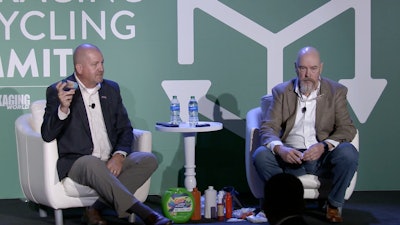Coming out of our inaugural Packaging Recycling Summit (PRS), the Packaging World team is departing Atlanta with wind in our sails. You might ask yourself, “Another sustainability conference?” Sure enough, there are plenty of remarkable events in the packaging and sustainability space. But we think PRS treads unexplored territory in packaging circularity and bridges several gaps.
In our magazine, we tailor our reporting to you, the CPG, by covering both upstream OEMs and materials suppliers and your customers downstream, including retailers and consumer trends impacting your brands. The CPG point of view is at our core, and anchors our perspective.
The drawback of our upstream/downstream mental model is that it lends itself to the idea that the entire supply chain is necessarily linear, where packaging vanishes behind the horizon as it travels to an unknown terminus beyond a CPG’s jurisdiction (and responsibility, though EPR might forecefully change that attitude). Whether it’s landfilled, incinerated, or ends up in the environment, that’s packaging’s end of the line. Even when packaging is recycled, often for a CPG, processes of hauling, sortation, recovery, and reprocessing might as well be the dark side of the moon.
This disconnect partially stems from consumers acting as an unpredictable gap between responsible stakeholders in a potentially circular supply chain. There is no clear ownership transfer or chain of custody for a package from CPG or retailer to Material Recovery Facilities (MRFs) or recovery centers. Consumers form an enigmatic black box in this process.
Because of this gap, brands allow themselves to wash their hands of packaging’s end-of-life fate, leaving it to the whims of consumers who claim to want sustainable packaging but often won’t recycle it. Many CPGs focus solely on making packaging recyclable (or “recycle-ready”), treating technical recyclability as the lone KPI, with little regard for the actual recoverability of the package at scale. This shifts onus and responsibility downstream, and brands let themselves off the hook.
To become genuine partners in a circular system, brands must design packaging that they can be confident is recovered and recycled. Procter & Gamble’s engagement with MRF Rumpke, conducting RFID pass through trials on package recovery, is an excellent example of how to do this. P&G’s Mark Agerton and Rumpke’s Jeff Snyder shared their inspiring collaboration with our 350 in-person and online attendees at PRS.
Brands also bear the responsibility of enhancing recoverability and increasing feedstock for Post-Consumer Recycled (PCR) materials through consumer education on good recycling behavior. They have a direct connection with consumers and benefit from a positive sustainability image. Collaborating with organizations like Sustainable Packaging Coalition’s How2Recycle and The Recycling Partnership’s Recycle Check can bridge the consumer-to-disposal gap and help activate circularity.
Taking it a step further, CPGs and brands must become customers of reprocessors and converters offering PCR, becoming their own end market by purchasing PCR as packaging input.
With PRS, our goal is to help brands transform themselves from passive producers of theoretically recyclable waste into active participants in a circular economy. Models like MBOLD (read more about it here) are already demonstrating that it’s realistic, and there are other promising programs with similar models currently rolling out, including some we just discovered at PRS.
Instead of solely focusing on contiguous links of the supply chain, the new summit engages MRFs and reprocessors who not only identify recyclable materials but also those likely to be sold for profit to plastic converters, aluminum smelters, paper mills, pulpers, or glass remelters. We involve materials suppliers purchasing PCR from reprocessors and converting it into new packaging for brands. We also engage packaging OEMs wrestling with new materials and PCR. By understanding the unique realities and motivations at each segment of the value chain, CPGs can unlock a profitable circular economy that benefits all stakeholders. Every link in the chain must derive economic value for this concept to succeed. While legislation or regulation may temporarily support certain segments, a solid economic foundation is vital to activate a circular packaging economy.
In the print version of this column, which just arrived in mailboxes, I've received a some good feedback reminding me how hard CPGs have it when it comes to circularity and blame for packaging waste.
“It is a difficult situation and the CPGs are unfairly being held responsible. There is much of that going on these days,” Bob Kelly of General Packaging Equipment Co. out of Houston pointed out to me in an e-mail.
I really do agree with Bob, here. Brands and CPGs alone shouldn't shoulder the entire burden, as they so often do in the public eye, especially when the consumers that make up the public tend to be the issue. But they (and perhaps retailers) are closest to consumers and have the most influence over them, so fairly or not, they're saddled with this outsized responsibility. And many can do more, considering how much benefit accrues to them by mere perceptions of sustainable action.
What do you think? Care to join us for the second round of the Packaging Recycling Summit, scheduled for September 16-18 in Anaheim, Calif.? Visit the event web page, here, to watch videos of this year's event and learn more about next year's. Hope to see you there. PW

























